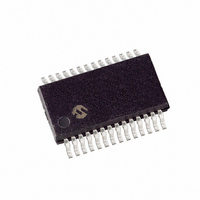PIC16F870T-I/SS Microchip Technology, PIC16F870T-I/SS Datasheet - Page 26

PIC16F870T-I/SS
Manufacturer Part Number
PIC16F870T-I/SS
Description
IC MCU FLASH 2KX14 EE 28SSOP
Manufacturer
Microchip Technology
Series
PIC® 16Fr
Datasheets
1.PIC16F616T-ISL.pdf
(8 pages)
2.PIC16F688T-ISL.pdf
(688 pages)
3.PIC16F870-ISO.pdf
(172 pages)
4.PIC16F870-ISO.pdf
(6 pages)
Specifications of PIC16F870T-I/SS
Core Processor
PIC
Core Size
8-Bit
Speed
20MHz
Connectivity
UART/USART
Peripherals
Brown-out Detect/Reset, POR, PWM, WDT
Number Of I /o
22
Program Memory Size
3.5KB (2K x 14)
Program Memory Type
FLASH
Eeprom Size
64 x 8
Ram Size
128 x 8
Voltage - Supply (vcc/vdd)
4 V ~ 5.5 V
Data Converters
A/D 5x10b
Oscillator Type
External
Operating Temperature
-40°C ~ 85°C
Package / Case
28-SSOP
For Use With
I3-DB16F871 - BOARD DAUGHTER ICEPIC3
Lead Free Status / RoHS Status
Lead free / RoHS Compliant
PIC16F870/871
2.3
The Program Counter (PC) is 13-bits wide. The low
byte comes from the PCL register, which is a readable
and writable register. The upper bits (PC<12:8>) are
not readable, but are indirectly writable through the
PCLATH register. On any RESET, the upper bits of the
PC will be cleared. Figure 2-3 shows the two situations
for the loading of the PC. The upper example in the fig-
ure shows how the PC is loaded on a write to PCL
(PCLATH<4:0>
ure shows how the PC is loaded during a CALL or GOTO
instruction (PCLATH<4:3>
FIGURE 2-3:
2.3.1
A computed GOTO is accomplished by adding an offset
to the program counter (ADDWF PCL). When doing a
table read using a computed GOTO method, care
should be exercised if the table location crosses a PCL
memory boundary (each 256-byte block). Refer to the
application note, “Implementing a Table Read"
(AN556).
2.3.2
The PIC16FXXX family has an 8-level deep x 13-bit
wide hardware stack. The stack space is not part of
either program or data space and the stack pointer is
not readable or writable. The PC is PUSHed onto the
stack when a CALL instruction is executed, or an inter-
rupt causes a branch. The stack is POPed in the event
of a RETURN, RETLW or a RETFIE instruction
execution. PCLATH is not affected by a PUSH or POP
operation.
DS30569B-page 24
PC
PC
12
12 11 10
2
PCL and PCLATH
5
PCH
PCLATH<4:3>
PCH
COMPUTED GOTO
STACK
PCLATH
PCLATH<4:0>
8
PCLATH
8
PCH). The lower example in the fig-
7
7
LOADING OF PC IN
DIFFERENT SITUATIONS
PCL
PCL
PCH).
11
8
0
0
Instruction with
PCL as
Destination
ALU
GOTO,CALL
Opcode <10:0>
The stack operates as a circular buffer. This means that
after the stack has been PUSHed eight times, the ninth
push overwrites the value that was stored from the first
push. The tenth push overwrites the second push (and
so on).
2.4
The PIC16FXXX architecture is capable of addressing
a continuous 8K word block of program memory. The
CALL and GOTO instructions provide 11 bits of the
address, which allows branches within any 2K program
memory page. Therefore, the 8K words of program
memory are broken into four pages. Since the
PIC16F872 has only 2K words of program memory or
one page, additional code is not required to ensure that
the correct page is selected before a CALL or GOTO
instruction is executed. The PCLATH<4:3> bits should
always be maintained as zeros. If a return from a CALL
instruction (or interrupt) is executed, the entire 13-bit
PC is popped off the stack. Manipulation of the
PCLATH is not required for the return instructions.
2.5
The INDF register is not a physical register. Addressing
the INDF register will cause indirect addressing.
Indirect addressing is possible by using the INDF reg-
ister. Any instruction using the INDF register actually
accesses the register pointed to by the File Select reg-
ister, FSR. Reading the INDF register itself indirectly
(FSR = 0) will read 00h. Writing to the INDF register
indirectly results in a no operation (although status bits
may be affected). An effective 9-bit address is obtained
by concatenating the 8-bit FSR register and the IRP bit
(STATUS<7>), as shown in Figure 2-4.
A simple program to clear RAM locations 20h-2Fh
using indirect addressing is shown in Example 2-1.
EXAMPLE 2-1:
NEXT
CONTINUE
Note 1: There are no status bits to indicate stack
:
2: There are no instructions/mnemonics
Program Memory Paging
Indirect Addressing, INDF and
FSR Registers
movlw
movwf
clrf
incf
btfss
goto
overflow or stack underflow conditions.
called PUSH or POP. These are actions
that occur from the execution of the CALL,
RETURN, RETLW and RETFIE instruc-
tions, or the vectoring to an interrupt
address.
0x20
FSR
INDF
FSR,F
FSR,4
NEXT
INDIRECT ADDRESSING
2003 Microchip Technology Inc.
;initialize pointer
;to RAM
;clear INDF register
;inc pointer
;all done?
;no clear next
;yes continue


















